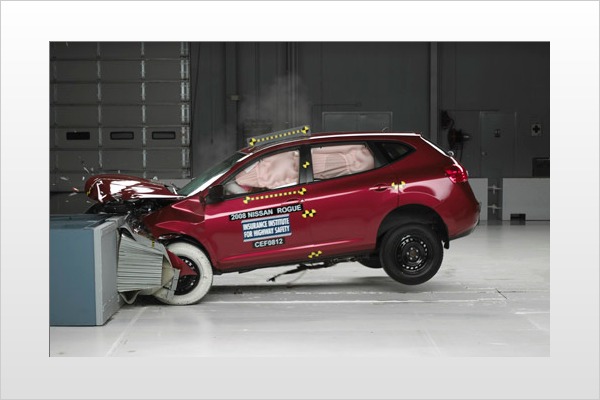
The federal government's New Car Assessment Program (NCAP) began in 1978, and went through a major revision in 2010. But it's not the only vehicle-safety testing and rating program in the U.S. Since 1995, the Insurance Institute for Highway Safety (IIHS), a nonprofit research and communications organization funded by auto insurers, also has been crashing cars with the aim of improving their safety (and lowering repair costs).
The two organizations perform different tests, and report the results differently: The New Car Assessment Program, which is administered by the National Highway Traffic Safety Administration (NHTSA), uses a star system, while IIHS uses a ranked, color-coded system of Good, Acceptable, Marginal and Poor. IIHS also issues a list of Top Safety Picks each year. And although consumers might be confused about who has stars and who has color bars, there's agreement that more testing programs are better than fewer when it comes to automotive safety.
"It's a good thing to have more than one rating system," said Henry Jasny, general counsel for Advocates for Highway and Auto Safety, an alliance of consumer, health and safety groups and insurance companies and agents. Because IIHS and NHTSA perform different kinds of crash tests, consumers get a more complete range of safety information, he said.
IIHS President Adrian Lund said he occasionally is asked which system consumers should pay attention to, and he thinks buyers should research widely. "I say that you shouldn't buy a car that's marginal or poor in any test," he said. "I would look for a car that does well across the board."
In a 2010 interview, then-NHTSA Administrator David Strickland agreed — to a point. He praised IIHS as having "fantastic" information, and said that Consumer Reports' safety testing information is also valuable. "More information to give the consumers is always good," he said, and urged car shoppers to do their safety homework. But he added that NHTSA is the agency responsible for vehicle safety standards and its tests are best. "The bottom line is that the National Highway Traffic Safety Administration's five-star safety rating test is the most stringent testing body out there with these new improvements," he said.
Advocates for Highway and Auto Safety, however, has a bone to pick with those stars. "The star system has become the state of the art for the government," Jasny said. "We never liked it." The New Car Assessment program can award a car one star even if it performs poorly and is "minimally compliant," he said. But a consumer could look at the vehicle and say, "Well, this gets a star," and believe that's a positive thing. "We felt that could be misleading," Jasny said. For the record, a one-star rating for a test means that there's a 46 percent or greater chance of serious injury.
Lund said IIHS began its testing program precisely because people still were dying in car crashes, despite the frontal-crash testing that the government had been doing for 17 years, and improvements that its tests had brought about in vehicle safety. By 1995, he said, most vehicles were performing well in the government's frontal crash test, earning four and five stars for safety.
"But people are still dying in frontal crashes," Lund said. It's still a problem today. According to IIHS, about half of the crash deaths occur in frontal crashes. "We looked at why people were dying, even though they were seatbelted, and we found intrusion was a big part of the problem." In a crash that's not totally head-on, there is less of a vehicle's area to manage the energy of the crash, so there is more structural damage to the occupant compartment, and passengers are more prone to injury.
The government's full-frontal test wasn't set up to assess that kind of crash. So IIHS began its own frontal-offset crash testing. "In a frontal crash, the whole vehicle is trying to protect the passengers," explains Jasny, of Advocates for Highway and Auto Safety. "When it's offset, and only part of the vehicle is involved in energy absorption, it's a tougher test."
When IIHS presented its first frontal-offset test result in 1995, cars that it rated marginal or poor were by and large those that NHTSA had awarded three stars — at least. There were also some four- and five-star cars, Lund said. More recently, IIHS introduced the small overlap crash test, which further raised the bar.
Those are examples of why, in Lund's view, the IIHS program might trump the government's. IIHS doesn't have the "hard slog" of political pressure and regulatory red tape that NHTSA faces when it comes to changing or adding tests. The fact that it has taken NHTSA until 2010 to raise its testing bar is proof of that, Lund said.
"Generally speaking, I think we're ahead of the federal government because we can move more quickly," he said. "We're better in the sense that we address new ways in which people need to be protected. We're typically finding problems in vehicles that NHTSA says are good."
But safety testing is not an either-or proposition, he said. "In many cases, these crash tests are complementary. When you're buying a car, you want to be protected in all crashes. If you're a consumer, you're looking for a vehicle that is doing well in all tests — the government's and ours. You don't know what kind of crash you're going to be involved in."